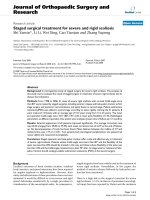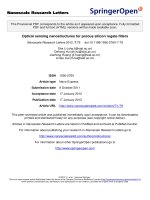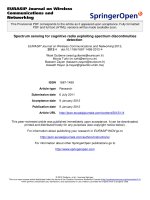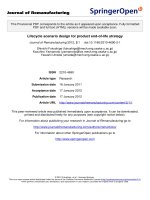Báo cáo toán học: " Optical sensing nanostructures for porous silicon rugate filters" doc
Bạn đang xem bản rút gọn của tài liệu. Xem và tải ngay bản đầy đủ của tài liệu tại đây (1.1 MB, 17 trang )
This Provisional PDF corresponds to the article as it appeared upon acceptance. Fully formatted
PDF and full text (HTML) versions will be made available soon.
Optical sensing nanostructures for porous silicon rugate filters
Nanoscale Research Letters 2012, 7:79 doi:10.1186/1556-276X-7-79
Sha Li ()
Dehong Hu ()
Jianfeng Huang ()
Lintao Cai ()
ISSN 1556-276X
Article type Nano Express
Submission date 9 October 2011
Acceptance date 17 January 2012
Publication date 17 January 2012
Article URL />This peer-reviewed article was published immediately upon acceptance. It can be downloaded,
printed and distributed freely for any purposes (see copyright notice below).
Articles in Nanoscale Research Letters are listed in PubMed and archived at PubMed Central.
For information about publishing your research in Nanoscale Research Letters go to
/>For information about other SpringerOpen publications go to
Nanoscale Research Letters
© 2012 Li et al. ; licensee Springer.
This is an open access article distributed under the terms of the Creative Commons Attribution License ( />which permits unrestricted use, distribution, and reproduction in any medium, provided the original work is properly cited.
Optical sensing nanostructures for porous silicon rugate filters
Sha Li
1
, Dehong Hu
1
, Jianfeng Huang
1
, and Lintao Cai*
1
1
CAS Key Lab of Health Informatics, Shenzhen Key Laboratory of Cancer Nanotechnology,
Institute of Biomedical and Health Engineering, Shenzhen Institutes of Advanced
Technology, Chinese Academy of Sciences, Xueyuan Avenue 1068, Shenzhen University
Town, Shenzhen, 518055, People's Republic of China
*Corresponding author:
Email addresses:
SL:
DH:
JH:
LC:
Abstract
Porous silicon rugate filters [PSRFs] and combination PSRFs [C-PSRFs] are emerging as
interesting sensing materials due to their specific nanostructures and superior optical
properties. In this work, we present a systematic study of the PSRF fabrication and its
nanostructure/optical characterization. Various PSRF chips were produced with resonance
peaks that are adjustable from visible region to near-infrared region by simply increasing the
periods of sine currents in a programmed electrochemical etching method. A regression
analysis revealed a perfect linear correlation between the resonant peak wavelength and the
period of etching current. By coupling the sine currents with several different periods,
C-PSRFs were produced with defined multiple resonance peaks located at desired positions.
A scanning electron microscope and a microfiber spectrophotometer were employed to
analyze their physical structure and feature spectra, respectively. The sensing properties of
C-PSRFs were investigated in an ethanol vapor, where the red shifts of the C-PSRF peaks
had a good linear relationship with a certain concentration of ethanol vapor. As the
concentration increased, the slope of the regression line also increased. The C-PSRF sensors
indicated the high sensitivity, quick response, perfect durability, reproducibility, and
versatility in other organic gas sensing.
Background
Porous silicon [PSi], a material with unique structural and optical properties, can be prepared
by anodic etching of silicon in ethanolic hydrofluoric acid solution [1-3]. By changing the
current density, the porosity of PSi that decides the refractive index can be tailored in a wide
range, and thus, it is able to obtain many types of PSi optical structures such as porous
silicon microcavities and porous silicon rugate filters [PSRFs]. Among them, PSRFs are a
class of multilayered photonic crystal with a sinusoidal refractive index distribution that is
normal to the surface. Light incident on the surface of a rugate filter will be reflected in a
narrow spectral range, and spectral position is dependent on the refractive index of the
material [4]. PSRFs were introduced and further improved afterwards by different groups
[5-9]. For example, by placing the electrode in a different way, a porous silicon band filter
gradient that displayed rainbow colors on its surface was prepared [6], and by employing an
amplitude-modulated sinusoidal refractive index apodized with a Gaussian function, the
optical property was greatly improved as a stop band at a wavelength of 850 nm yet with the
full-width at half maximum [FWHM] being only 5 nm [7, 8]. Notably, the location of its
peak was found to be determined by the period of the waveform used in the preparation [9].
Recently, combination PSRFs [C-PSRFs] have been developed. One kind of C-PSRF was
designed with two peaks in their reflectance spectra and combined with two multilayered
mirrors, among which the hydrophobic one was at the top and the hydrophilic one, at the
bottom [10, 11]. These C-PSRFs have been used to manipulate the movement of liquid
droplets [10] and local heating [11]. Another kind of C-PSRF was constituted by combined
multilayered mirrors and generated by coupling n sine waves with different frequencies used
for PSRF preparation [12]. By contrast, these C-PSRFs were applied for biomolecular
screening [5] or encoded microcarriers [12]. However, the nanostructure and optical
characterization have not been studied systematically.
Herein, we reported a systematic study on the fabrication and characterization of PSRFs
and C-PSRFs, especially on the relationships of position, FWHM, and intensity of their
optical resonance peaks with the period of sinusoidal current density applied in the synthesis.
Also, a scanning electron microscope and a microfiber spectrophotometer were employed to
analyze their physical nanostructure and feature spectra, respectively. The novel C-PSRF
with three synchronous peaks was used to detect the response to ethanol vapor, and the red
shifts of the C-PSRF peaks had a good linear relationship with a certain concentration of
ethanol vapor. As the concentration increased, the slope of the regression line also increased.
The C-PSRF sensors indicated high sensitivity, quick response, perfect durability, and
reproducibility.
Methods
Apparatus
Thickness and configuration measurements of the resulting PSRFs were carried out with a
field-emission scanning electron microscope [FESEM] (S4700, Hitachi High-Tech,
Minato-ku, Tokyo, Japan). The reflectance spectra (200 to 1,100 nm) of the PSRFs were
collected by a fiber optic spectrometer (AvaLight-DHS, Avantes BV, Apeldoorn, The
Netherlands) with a halogen lamp as light source. The resolution of the spectrometer is 0.8
nm.
Reagents
The highly doped p-type Si wafers (boron-doped, 0.002 to 0.004 Ω·cm resistivity) were
obtained from Silicon Valley Microelectronics, Inc. (Santa Clara, CA, USA). Hydrofluoric
acid [HF] was obtained from Chemical Reagent Company, Ltd. of Dongguan City,
Guangdong, China. All other chemicals used in this study were of analytical reagent grade
and used without further purification. A JL-RO100 Milli-pore-Q Plus water (Millipore Co.,
Billerica, MA, USA) purifier supplied deionized water with a resistivity of 18.25 MΩ·cm.
PSRF preparation
PSRFs were prepared by electrochemical anodization on highly doped p-type Si wafers
(boron-doped, 0.002 to 0.004 Ω·cm resistivity). Immediately before anodization, the
substrates were cleaned in propanol in an ultrasonic bath and rinsed in deionized water.
Anodization was performed under standard galvanostatic conditions in a 3:1 (v/v) solution of
49% aqueous HF and ethanol. A Teflon etch cell that exposed 0.46 cm
2
of the Si wafer was
employed. A platinum mesh electrode was immersed into the electrolyte as a counter
electrode, and silicon was anodized using a computer-controlled current source (2400
SourceMeter, Kiethley Instruments Inc., Cleveland, OH, USA). The current density was
modulated with a sinusoidal waveform (Figure 1) varying from 10 to 50 mA·cm
−2
and
cycled 30 times. Such a wide range of the current density was indispensable to achieve a
porosity modulation in the structure. The periods for these sine waves were between 2.4 to
6.9 s. After formation, the samples were rinsed with pure ethanol and were dried with
nitrogen gas.
C-PSRF preparation
Three sine waves with 30 periods and different frequencies (e.g., PSRF1, PSRF2, and
PSRF3; Figure 1) were coupled to generate a combined waveform (Figure 1) that was then
converted into a current-time waveform by the computer-controlled current source (2400
SourceMeter, Kiethley Instruments Inc., Cleveland, OH, USA). The converted waveform
was then applied to etch a porosity-depth profile in the Si wafer, yielding the C-PSRFs
[13].
Other conditions were kept the same as described in the PSRF preparation.
Prior to anodization, all the silicon wafers were dipped in 5 wt.% HF solution to remove
the native oxides. After anodization, all the samples were rinsed with ethanol and then dried
under a gentle stream of nitrogen gas.
Ethanol sensing
For ethanol monitoring experiments, the PSRF wafers were placed in a sealed steel
chamber with a window that was covered with a quartz glass, in which the detecting vapors
were transported at room temperature. The dry ethanol vapors were produced by the
bubbling of nitrogen with a flow rate of 100 sccm into an ethanol aqueous solution with
different concentrations and dried by passing through a pipe filled with anhydrous Na
2
CO
3
.
Results and discussion
The PSRF structure was observed in various aspects using a FESEM. As can be seen from
Figure 2a, the PSRF showed a sinusoidal-varying porosity gradient in the direction
perpendicular to the plane of the filter, where the higher porosity film by high-current
etching was in the dark zone, whereas the lower porosity film by low-current etching was
located in the bright zone. The whole thickness for the stack layer of each sinusoidal period
was about 285 nm on average. A magnified cross-sectional view (inset) revealed that the
porous structure was made up of nanopores, where the inside walls of the nanopores were
rather rough. Figure 2b showed the top view SEM image of the PSRF, where the pore sizes
were 2 to 10 nm.
Figure 3 showed the reflectance spectra of a series of PSRFs produced with sinusoidal
current densities of different periods. It was clear that there was a resonance peak in each
feature spectrum. As the current periods increased, the resonance peak shifted from the
visible region to the near-infrared region, and the FWHM also increased. A regression
analysis revealed a perfect linear correlation between the resonant peak wavelength (λ,
nanometer) and the etching time (T, seconds) (λ = 161.961 + 129.659 T, R = 0.996; Figure
4a).
As the porosity could be controlled by the etching current density, with the pore
dimensions in these structures too small to effectively scatter light and each porous layer
treated as a single medium with a single refractive index value, the resulting linear relation
between the peak wavelength (λ) and the period of the sinusoidal current (T) described above
could be explained in Equation 1 as follows:
= 2
m nL
λ
, (1)
where m was the spectral order of the fringe at wavelength λ, n was the refractive index, L
was the thickness of the film, and nL was the optical thickness [14-16].
It was obvious that the PSRFs with peaks ranging from short to long wavelengths could
be obtained by increasing the thickness of each layer, which was controlled by the duration
of the etch cycle
[5].
In the meantime, it can be seen that the intensity and FWHM of those peaks increased
along with the peak wavelength. A linear relationship of the peak intensity (I) and the period
(T) was obtained as I = −10.169 + 9.570 T (s) with a linear correlation coefficient of R =
0.997 (number 1 in Figure 4b), and the relationship between FWHM and the period was
FWHM = 7.370 + 31.188 T (s) with a linear correlation coefficient of R = 0.993 (number 2 in
Figure 4b). The linear strengthening intensity was mainly caused by the increasing photon
number that was the result of the linear increasing thickness of the optical structure layer and
the easier photonic diffraction when the peak wavelength increased. As to the same reason
why the FWHM linearly broadened, it could be derived from Equation 2:
34 8
19
6.63 10 3.00 10 1243.125
(m) (nm)
1.6 10
hc
E W W
λ
−
−
× × ×
= = =
× ×
, (2)
where λ was the wavelength of peak in the spectrum, h was Planck's constant, c was the
speed of light, and energy (E, joules) and work (W, electron volt) were photon energies. As
can be seen, the wavelength (λ) red shifts resulted in the lower photon energy (W).
Based on the discussion above, C-PSRFs were designed using three sine waves with
periods of 3.105, 3.45, and 4.14 s, where the combined current were coupled to generate a
combination waveform by the computer-controlled current source, etching a porosity-depth
profile into the Si wafer. By comparing the peak positions of the C-PSRFs (i.e., 510.7, 549.9,
and 630.5 nm ) and PSRFs (i.e., 511.4, 549.4, and 630.5 nm), it indicated that the peak
positions of C-PSRFs were exactly kept in the same peak positions as in the single PSRFs
with the difference of less than 1 nm (Figure 5). All the sinusoidal current densities used in
this work were of the same variation from 10 to 50 mA·cm
−2
for 30 cycles. Moreover, we
have already produced C-PSRFs with two resonance peaks by the same process, so C-PSRFs
with specific peak numbers and peak positions could be controllably produced by
modulating the numbers and periods of the combined current by single sine waves that were
coupled. In addition, it could be seen that the peak intensity varied, which could be attributed
to the interaction of the three coupled sine waves and the optical structures.
C-PSRF was a type of promising sensing material for ethanol optical sensors. As shown in
Figure 6, upon the exposure of ethanol vapor, the C-PSRF showed dramatic red shifts in its
peaks. Specifically, the peaks at the positions of a
1
, b
1
, and c
1
shifted to the positions of a
2
, b
2
,
and c
2
, respectively, and the amounts of the red shifts for a
1
, b
1
, and c
1
were 26.4, 31.1, and
40.2 nm, respectively. Obviously, under the same conditions, the red shifts for three peaks
were different. A perfect linear relationship between the amounts of red shifts (Rs,
nanometer) and the wavelengths of the original peaks (λ, nanometer) could be obtained as Rs
= −30.968 + 0.109 λ with a correlation coefficient of R = 1.000.
When the ethanol vapors were desorbed through exposure of N
2
, the peaks would quickly
return to their exact initial positions (see a
3
, b
3
, and c
3
in Figure 6). This process was
completely reversible and repeatable even after several cycles of exposure. The same value
for each measurement within the experiment error has been obtained from the process that
has been repeated three times. The response time to ethanol vapors and recovery time from
N
2
were as rapid as within 5 s.
To further study the sensing properties of C-PSRFs, a gas mixture of N
2
with ethanol
vapor at different concentrations (Figure 7a) was exposed to the chip. Figure 7a showed the
corresponding red shifts for the three peaks as a function of the ethanol concentration. At a
low concentration (<100 ppm), the red shifts (Rs, nanometer) gave a good linear relationship
with the concentration (C, parts per million). The regression equations for three peaks, i.e.,
left, middle, and right peaks, were Rs
1
= 2.623 + 0.199 C
1
(correlation R
1
= 0.991), Rs
2
=
2.933 + 0.239 C
2
(correlation R
2
= 0.993), and Rs
3
= 3.794 + 0.302 C
3
(correlation R
3
=
0.994), respectively. Calculated from the slopes of the equations, obtained were the
sensitivities of the three peaks as 0.200, 0.239, and 0.302 nm·ppm
−1
. Notably, compared with
the two left peaks, the right peak that was situated at a longer wavelength displayed the
highest sensitivity. Figure 7b illustrated the red shift of each peak as a function of the peak's
initial position when ethanol vapor with different concentrations was exposed to the C-PSRF
chip. As can be seen, the shifts for each peak show a good linear relationship with the peaks'
initial positions when a certain concentration of ethanol was exposed, and the slope for the
regression line increases with the concentration. Specifically, the slope coefficients for these
lines were calculated from the bottom to the top as 0.0079, 0.012, 0.0290, 0.0521, 0.0751,
0.087, 0.098, and 0.1098. Hence, another linear equation of the slope coefficient (K) as a
function of their corresponding concentration (C, parts per million) could be obtained as K =
0.0095 + 0.0008 C with a correlation of R = 0.996 (see the inset of Figure 7b). Therefore,
based on the results of the standard curves mentioned above, whatever red shift of the peaks
(i.e., left, middle, or right) or slope coefficient of the three peaks was measured, it gave way
for the calculation of the corresponding concentration of ethanol employed in the sensing
experiments. The peak located at a shorter wavelength held a small FWHM, while the peak
situated at a longer wavelength provided a larger red shift in the sensing process. Thus, the
C-PSRF sensors preformed with good selectivity, high sensitivity, and multiplex detection
together to be great and efficient, and thus promising in sensing applications.
While these values reflect the sensitivity to a given volume (or mass) of the analyte, it is
important to point out that the slope coefficient for a given analyte is profoundly influenced
by the adsorption and microcapillary condensation processes operative in these PSRF
sensors. The high surface area and the existence of a large volume fraction of micropores
both contribute in concentrating the analyte vapors in the sensor. Consequently, the slope
coefficient is expected to be substantially reduced, in particular, for molecules that have high
sticking probabilities and low vapor pressures [13].
Conclusions
In summary, we have presented a systematic study on the preparation of PSRFs with
resonant peaks varying from the visible region to the near-infrared region. Those PSRFs
were electrochemically produced in a program-controlled current etching by systematically
tuning the periods of the sine currents. The PSRF resonant peak wavelength was observed as
a perfect linear correlation with the period of etching current. Moreover, C-PSRFs with
several peaks in the feature spectra were produced using a combination sine current that was
coupled with several single sine waves with different frequencies. The relationships between
the wavelength of the resonant peak, FWHM, peak intensity, and the periods were revealed.
Based on the C-PSRFs' unique nanostructure and multiplex peak detection, the sensing
properties of C-PSRFs were explored in the ethanol vapor. The sensing process of C-PSRFs
exhibited high sensitivity, quick response, and reproducible abilities, implying their
promising applications in gas sensor and biosensing fields.
Competing interests
The authors declare that they have no competing interests.
Authors' contributions
SL carried out the preparation of C-PSRF and drafted the manuscript. DH carried out the
ethanol monitoring experiments. JH participated in the ethanol monitoring experiments. LC
conceived the study and participated in its design and coordination. All authors read and
approved the final manuscript.
Acknowledgments
We gratefully acknowledge the financial support of the National Natural Science Foundation
of China (grant nos. 20875062 and 81071249), Shenzhen Science and Technology Projects
(SY200806300225A), the ‘Hundred Talents Program’ of Chinese Academy of Sciences, and
the Science and Technology Projects of Guangdong Province (grant no. 2009A030301010).
References
1. Kilian KA, Böcking T, Gaus K, King-Lacroix J, Gal M, Gooding JJ: Hybrid lipid
bilayers in nanostructured silicon: a biomimetic mesoporous scaffold for optical
detection of cholera toxin. Chem Commun 2007, 1936-1938.
2. Sciacca B, Secret E, Pace S, Gonzalez P, Geobaldo F, Quignard F, Cunin F:
Chitosan-functionalized porous silicon optical transducer for the detection of
carboxylic acid-containing drugs in water. J Mater Chem 2011, 21:2294-2302.
3. Sam SS, Chazalviel JN, Gouget-Laemmel AC, Ozanam FF, Etcheberry AA, Gabouze NE:
Peptide immobilisation on porous silicon surface for metal ions detection. Nanoscale
res lett 2011, 6:412.
4. Kilian KA, Böcking T, Ilyas S, Gaus K, Jessup W, Gal M, Gooding JJ: Forming
antifouling organic multilayers on porous silicon rugate filters towards in vivo/ex
vivo biophotonic devices. Adv Funct Mater 2007, 17:2884-2890.
5. Cunin F, Schmedake TA, Link JR, Li YY, Koh J, Bhatia SN, Sailor MJ: Biomolecular
screening with encoded porous silicon photonic crystals. Nat Mater 2002, 1:39-40.
6. Li YY, Kim P, Sailor MJ: Painting a rainbow on silicon – a simple method to generate
a porous silicon band filter gradient. Phys Stat Sol (a) 2005, 202:1616-1618.
7. Ilyas S, Gal M: Optical devices from porous silicon having continuously varying
refractive index. J Mater Sci: Mater Electron 2007, 18:S61-S64.
8. Ilyas S, Böcking T, Kilian K, Reece PJ, Gooding J, Gaus K, Gal M: Porous silicon based
narrow line-width rugate filters. Opt Mater 2007, 29:619-622.
9. Orosco MM, Pacholski C, Miskelly GM, Sailor MJ: Protein-coated porous silicon
photonic crystals for amplified optical detection of protease activity. Adv Mater 2006,
18:1393-1396.
10. Dorvee JR, Derfus AM, Bhatia SN, Sailor MJ: Manipulation of liquid droplets using
amphiphilic, magnetic 1-D photonic crystal chaperones. Nat Mater 2004, 3:896-899.
11. Park JH, Derfus AM, Segal E, Vecchio KS, Bhatia SN, Sailor MJ: Local heating of
discrete droplets using magnetic porous silicon-based photonic crystals. J Am Chem
Soc 2006, 128:7938-7946.
12. Meade SO, Yoon MS, Ahn KH, Sailor MJ: Porous silicon photonic crystals as
encoded microcarriers. Adv Mater 2004, 16:1811-1814.
13. Salem MS, Sailor MJ, Fukami K, Sakka T, Ogata YH: Sensitivity of porous silicon
rugate filters for chemical vapor detection. J Appl Phys 2008, 103:083516.
14.Ouyang H, Christophersen M, Fauchet PM: Enhanced control of porous silicon
morphology from macropore to mesopore formation. Phys. Stat. Sol 2005,
202:1396-1401.
15. Pacholski C, Sartor M, Sailor MJ, Cunin F, Miskelly GM: Biosensing using porous
silicon double-layer interferometers: reflective interferometric Fourier transform
spectroscopy. J Am Chem Soc 2005, 127:11636-11645.
16. Anglin EJ, Schwartz MP, Ng VP, Perelman LA, Sailor MJ: Engineering the chemistry
and nanostructure of porous silicon Fabry-Pérot films for loading and release of a
steroid. Langmuir 2004, 20:11264-11269.
Figure 1. The current densities for PSRFs and the coupled density for C-PSRFs.
Figure 2. Cross-sectional view (a) and top view (b) of PSRF wafer FESEM images. The
inset is a magnified cross-sectional view. (PSRF was prepared with a sinusoidal waveform
ranging between 10 and 50 mA·cm
−2
with a period of 6.9 s for 30 cycles in a 3:1 (v/v)
solution of 49% aqueous hydrofluoric acid and ethanol.)
Figure 3. PSRFs' reflectance spectra prepared using varied sinusoidal current densities
and cycled 30 times. The densities were from 10 to 50 mA·cm
−2
, and the different periods
for the curves (a to g) were 5.52, 4.83, 4.14, 3.893, 3.105, 2.76, and 2.415 s, respectively.
Figure 4. Linear relationships. (a) Linear relationships between the wavelength and the
period (filled square). (b) Linear relationships between (1) the intensity and the period
(empty circle) and (2) the FWHM and the period (filled circle).
Figure 5. Reflectance spectra of PSRFs and C-PSRFs. PSRFs' reflectance spectra (upper
curve) etched with single periods of (a) 3.105, (b) 3.45, and (c) 4.14 s, respectively, and
reflectance spectrum of C-PSRFs (lower curve) with three peaks etched with the coupled
current density of three single periods of (a
1
) 3.105, (b
1
) 3.45, and (c
1
) 4.14 s. In both cases,
the sinusoidal current varied between 10 and 50 mA·cm
−2
and was cycled 30 times.
Figure 6. Reflectance spectra of C-PSRF. C-PSRF when exposed to N
2
(a
1
, b
1
, and c
1
), gas
mixture of N
2
and ethanol vapor (a
2
, b
2
, and c
2
), and N
2
(a
3
, b
3
, and c
3
).
Figure 7. Red shifts for the three peaks and their corresponding linear correlations. (a)
Red shifts for the three peaks of C-PSRFs when exposed to ethanol vapor with different
concentrations. (b) The linear correlations between the red shifts of the three peaks and the
peaks' initial positions when exposed to a certain concentration of ethanol vapor. The inset is
the linear correlation between the slope coefficient and the concentration of ethanol.
Figure 1
Figure 2
Figure 3
Figure 4
Figure 5
Figure 6
Figure 7









